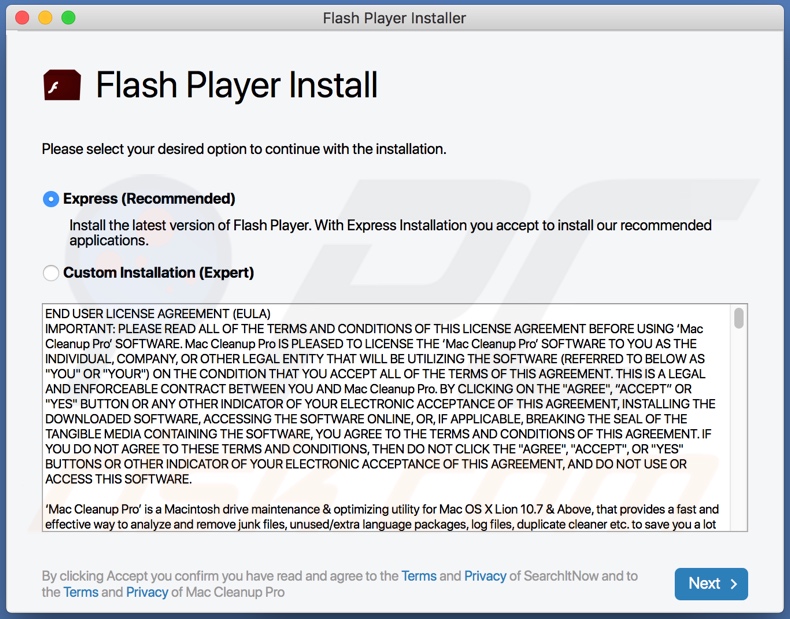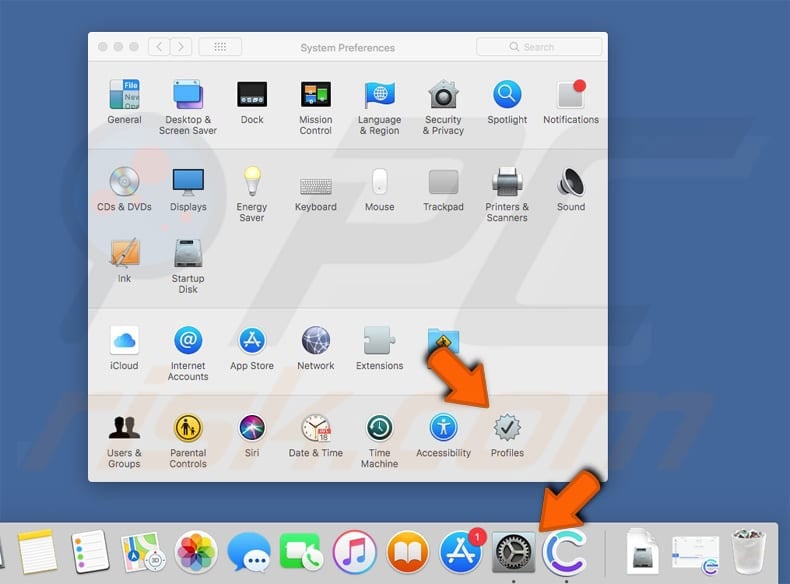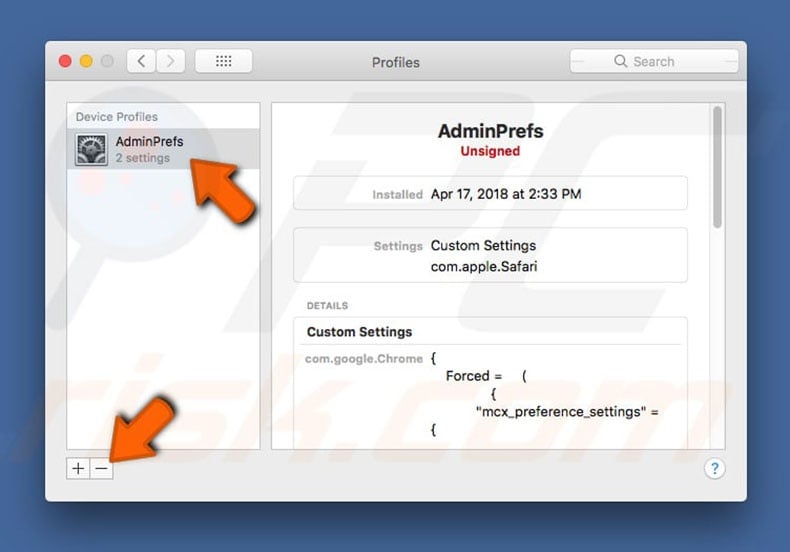How to remove EssentialCommand adware from the operating system
Mac VirusAlso Known As: Ads by EssentialCommand
Get free scan and check if your device is infected.
Remove it nowTo use full-featured product, you have to purchase a license for Combo Cleaner. Seven days free trial available. Combo Cleaner is owned and operated by RCS LT, the parent company of PCRisk.com.
What is EssentialCommand adware?
EssentialCommand is an adware-type application that also has browser hijacker traits. Following successful infiltration, it delivers intrusive advertisement campaigns, makes modifications to browser settings and promotes fake search engines.
Most adware and browser hijackers gather browsing-related information, and it is highly likely that EssentialCommand does so as well. Since most users download/install this app unintentionally, it is classified as a Potentially Unwanted Application (PUA). EssentialCommand has been observed being distributed via bogus Adobe Flash Player updates.
Note that fake software updaters/installers are used to proliferate various PUAs and malware (e.g. Trojans, ransomware, etc.).

Adware enables the placement of pop-ups, coupons, banners, full-page and other intrusive ads, usually, on any visited website. Therefore, the ads do not originate from the sites but are delivered by adware infiltrated into the system. Intrusive advertisements overlay web page content and reduce browsing speed.
Additionally, when clicked, they can redirect to dubious/malicious websites and some can even stealthily download/install rogue software (e.g. PUAs). Browser hijackers operate by assigning the addresses of bogus search engines as the homepage, default search engine and new tab/window URLs.
With this software installed, new browser tabs/windows opened and searches made through the URL bar redirect to the promoted address. Fake search engines are seldom capable of providing unique results, and so they redirect to Yahoo, Google, Bing and other legitimate sites.
Furthermore, recovering a hijacked browser is impossible without removing the software affecting it, since access to browser settings is restricted/denied and permitted changes made, automatically undone. As mentioned, most PUAs (e.g. adware, browser hijackers, etc.) have data tracking capabilities.
They can record users' browsing activity (URLs visited, pages viewed, search queries typed, etc.) and collect personal information extracted from it (IP addresses, geolocations and other details). This sensitive information is typically monetized by sharing with and/or selling to third parties.
To summarize, the presence of unwanted applications on devices can lead to system infections, financial loss, serious privacy issues and even identity theft. Therefore, you are strongly advised to eliminate all suspicious apps and browser extensions/plug-ins immediately upon detection.
| Name | Ads by EssentialCommand |
| Threat Type | Adware, Mac malware, Mac virus. |
| Detection Names | Avast (MacOS:AdAgent-L [Adw]), Endgame (Malicious (moderate Confidence)), ESET-NOD32 (A Variant Of OSX/Adware.Synataeb.C), Kaspersky (Not-a-virus:HEUR:AdWare.OSX.Adload.i), Full List (VirusTotal). |
| Additional Information | This application belongs to the Adload malware family. |
| Symptoms | Your Mac becomes slower than normal, you see unwanted pop-up ads, you are redirected to dubious websites. |
| Distribution methods | Deceptive pop-up ads, free software installers (bundling), fake Flash Player installers, torrent file downloads. |
| Damage | Internet browser tracking (potential privacy issues), display of unwanted ads, redirects to dubious websites, loss of private information. |
| Malware Removal (Windows) |
To eliminate possible malware infections, scan your computer with legitimate antivirus software. Our security researchers recommend using Combo Cleaner. Download Combo CleanerTo use full-featured product, you have to purchase a license for Combo Cleaner. 7 days free trial available. Combo Cleaner is owned and operated by RCS LT, the parent company of PCRisk.com. |
PromoteMethod, WebAdvancedSearch and ExtendedTask are some examples of other adware-type applications. They may seem legitimate and can offer various "useful" features, however, the promised functionality rarely works, and this is common to all PUAs.
The sole purpose of this unwanted software is to generate profit for the developers. Rather than delivering any real value, PUAs run intrusive advertisement campaigns, modify browsers, cause redirects and collect private data.
How did EssentialCommand install on my computer?
PUAs are distributed via the download/installation set-ups of other software. This deceptive marketing method of packing normal products with unwanted or malicious additions is termed "bundling".
By rushing through download/installation processes (e.g. ignoring terms, using pre-set options, etc.), many users risk unintentionally allowing bundled content into their devices, thereby endangering them with potential infections. Some PUAs have "official" download web pages. Intrusive ads proliferate these apps as well.
Once clicked, they can execute scripts to download/install PUAs without users' consent.
How to avoid installation of potentially unwanted applications
You are advised to research all products before download/installation. All downloads should be performed from official and verified sources. Untrusted download channels such as unofficial and free file-hosting websites, P2P sharing networks (BitTorrent, eMule, Gnutella, etc.) and other third party downloaders commonly offer deceptive and/or bundled content.
When downloading/installing, read the terms, explore all available options, use the "Custom" or "Advanced" settings and opt-out of supplementary apps, tools, features, and so on. Intrusive advertisements may seem legitimate, however, they can redirect to various dubious sites (e.g. gambling, pornography, adult-dating and others).
If you encounter ads/redirects of this kind, check the system and immediately remove all dubious applications and browser extensions/plug-ins. If your computer is already infected with EssentialCommand, we recommend running a scan with Combo Cleaner Antivirus for Windows to automatically eliminate this adware.
Files related to EssentialCommand adware that need to be removed:
- ~/Library/Application Support/com.EssentialCommand/EssentialCommand
- ~/Library/Application Support/com.EssentialCommandDaemon/EssentialCommand
- ~/Library/LaunchAgents/com.EssentialCommand.plist
- ~/Library/LaunchDaemons/com.EssentialCommandDaemon.plist
IMPORTANT NOTE! Rogue setups/apps that promote EssentialCommand adware are designed to create a new device profile. Therefore, before taking any further removal steps, perform these actions:
1) Click the "Preferences" icon in the menu bar and select "Profiles".

2) Select the "EssentialCommand" profile and delete it.

3) Perform a full system scan with Combo Cleaner anti-virus suite.
After performing these actions, you can proceed with further removal steps for this adware.
Instant automatic malware removal:
Manual threat removal might be a lengthy and complicated process that requires advanced IT skills. Combo Cleaner is a professional automatic malware removal tool that is recommended to get rid of malware. Download it by clicking the button below:
DOWNLOAD Combo CleanerBy downloading any software listed on this website you agree to our Privacy Policy and Terms of Use. To use full-featured product, you have to purchase a license for Combo Cleaner. 7 days free trial available. Combo Cleaner is owned and operated by RCS LT, the parent company of PCRisk.com.
Quick menu:
- What is EssentialCommand?
- STEP 1. Remove EssentialCommand related files and folders from OSX.
- STEP 2. Remove EssentialCommand ads from Safari.
- STEP 3. Remove EssentialCommand adware from Google Chrome.
- STEP 4. Remove EssentialCommand ads from Mozilla Firefox.
Video showing how to remove adware and browser hijackers from a Mac computer:
EssentialCommand adware removal:
Remove EssentialCommand-related potentially unwanted applications from your "Applications" folder:

Click the Finder icon. In the Finder window, select "Applications". In the applications folder, look for "MPlayerX","NicePlayer", or other suspicious applications and drag them to the Trash. After removing the potentially unwanted application(s) that cause online ads, scan your Mac for any remaining unwanted components.
DOWNLOAD remover for malware infections
Combo Cleaner checks if your computer is infected with malware. To use full-featured product, you have to purchase a license for Combo Cleaner. 7 days free trial available. Combo Cleaner is owned and operated by RCS LT, the parent company of PCRisk.com.
Remove adware-related files and folders

Click the Finder icon, from the menu bar. Choose Go, and click Go to Folder...
 Check for adware generated files in the /Library/LaunchAgents/ folder:
Check for adware generated files in the /Library/LaunchAgents/ folder:

In the Go to Folder... bar, type: /Library/LaunchAgents/

In the "LaunchAgents" folder, look for any recently-added suspicious files and move them to the Trash. Examples of files generated by adware - "installmac.AppRemoval.plist", "myppes.download.plist", "mykotlerino.ltvbit.plist", "kuklorest.update.plist", etc. Adware commonly installs several files with the exact same string.
 Check for adware generated files in the ~/Library/Application Support/ folder:
Check for adware generated files in the ~/Library/Application Support/ folder:

In the Go to Folder... bar, type: ~/Library/Application Support/

In the "Application Support" folder, look for any recently-added suspicious folders. For example, "MplayerX" or "NicePlayer", and move these folders to the Trash.
 Check for adware generated files in the ~/Library/LaunchAgents/ folder:
Check for adware generated files in the ~/Library/LaunchAgents/ folder:

In the Go to Folder... bar, type: ~/Library/LaunchAgents/

In the "LaunchAgents" folder, look for any recently-added suspicious files and move them to the Trash. Examples of files generated by adware - "installmac.AppRemoval.plist", "myppes.download.plist", "mykotlerino.ltvbit.plist", "kuklorest.update.plist", etc. Adware commonly installs several files with the exact same string.
 Check for adware generated files in the /Library/LaunchDaemons/ folder:
Check for adware generated files in the /Library/LaunchDaemons/ folder:

In the "Go to Folder..." bar, type: /Library/LaunchDaemons/

In the "LaunchDaemons" folder, look for recently-added suspicious files. For example "com.aoudad.net-preferences.plist", "com.myppes.net-preferences.plist", "com.kuklorest.net-preferences.plist", "com.avickUpd.plist", etc., and move them to the Trash.
 Scan your Mac with Combo Cleaner:
Scan your Mac with Combo Cleaner:
If you have followed all the steps correctly, your Mac should be clean of infections. To ensure your system is not infected, run a scan with Combo Cleaner Antivirus. Download it HERE. After downloading the file, double click combocleaner.dmg installer. In the opened window, drag and drop the Combo Cleaner icon on top of the Applications icon. Now open your launchpad and click on the Combo Cleaner icon. Wait until Combo Cleaner updates its virus definition database and click the "Start Combo Scan" button.

Combo Cleaner will scan your Mac for malware infections. If the antivirus scan displays "no threats found" - this means that you can continue with the removal guide; otherwise, it's recommended to remove any found infections before continuing.

After removing files and folders generated by the adware, continue to remove rogue extensions from your Internet browsers.
Remove malicious extensions from Internet browsers
 Remove malicious Safari extensions:
Remove malicious Safari extensions:

Open the Safari browser, from the menu bar, select "Safari" and click "Preferences...".

In the preferences window, select "Extensions" and look for any recently-installed suspicious extensions. When located, click the "Uninstall" button next to it/them. Note that you can safely uninstall all extensions from your Safari browser - none are crucial for regular browser operation.
- If you continue to have problems with browser redirects and unwanted advertisements - Reset Safari.
 Remove malicious extensions from Google Chrome:
Remove malicious extensions from Google Chrome:

Click the Chrome menu icon ![]() (at the top right corner of Google Chrome), select "More Tools" and click "Extensions". Locate all recently-installed suspicious extensions, select these entries and click "Remove".
(at the top right corner of Google Chrome), select "More Tools" and click "Extensions". Locate all recently-installed suspicious extensions, select these entries and click "Remove".

- If you continue to have problems with browser redirects and unwanted advertisements - Reset Google Chrome.
 Remove malicious extensions from Mozilla Firefox:
Remove malicious extensions from Mozilla Firefox:

Click the Firefox menu ![]() (at the top right corner of the main window) and select "Add-ons and themes". Click "Extensions", in the opened window locate all recently-installed suspicious extensions, click on the three dots and then click "Remove".
(at the top right corner of the main window) and select "Add-ons and themes". Click "Extensions", in the opened window locate all recently-installed suspicious extensions, click on the three dots and then click "Remove".

- If you continue to have problems with browser redirects and unwanted advertisements - Reset Mozilla Firefox.
Share:

Tomas Meskauskas
Expert security researcher, professional malware analyst
I am passionate about computer security and technology. I have an experience of over 10 years working in various companies related to computer technical issue solving and Internet security. I have been working as an author and editor for pcrisk.com since 2010. Follow me on Twitter and LinkedIn to stay informed about the latest online security threats.
PCrisk security portal is brought by a company RCS LT.
Joined forces of security researchers help educate computer users about the latest online security threats. More information about the company RCS LT.
Our malware removal guides are free. However, if you want to support us you can send us a donation.
DonatePCrisk security portal is brought by a company RCS LT.
Joined forces of security researchers help educate computer users about the latest online security threats. More information about the company RCS LT.
Our malware removal guides are free. However, if you want to support us you can send us a donation.
Donate
▼ Show Discussion